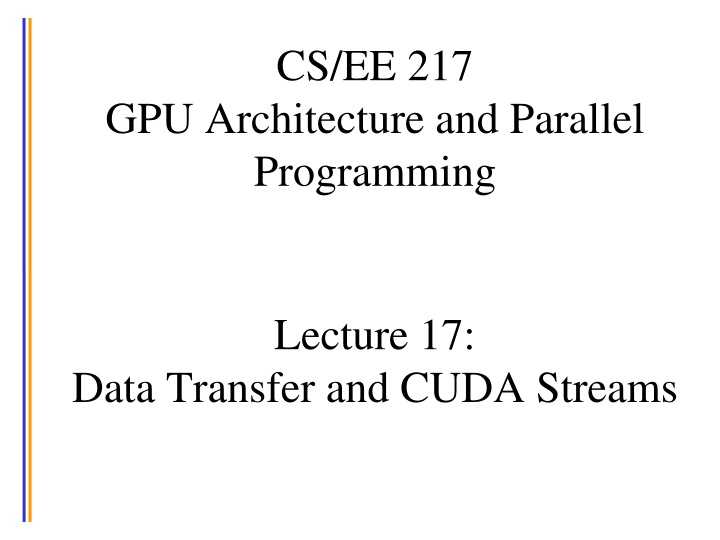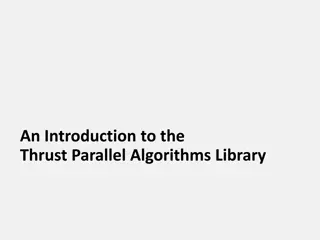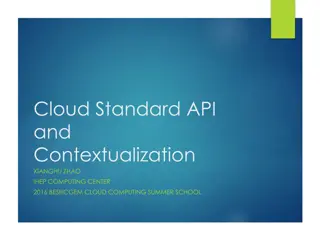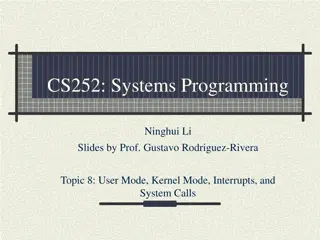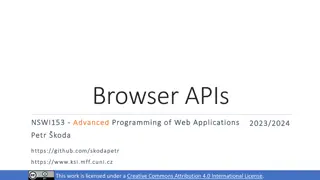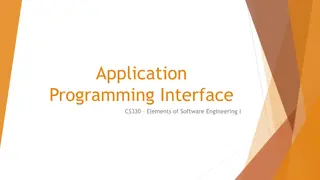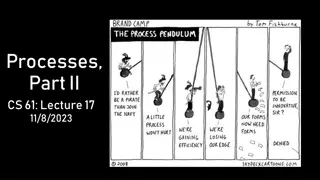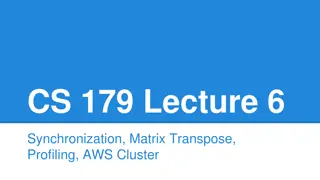Advanced Features of CUDA APIs for Data Transfer and Kernel Launch
This lecture covers advanced features of the CUDA APIs for data transfer and kernel launch, focusing on task parallelism for overlapping data transfer with kernel computation using CUDA streams. Topics include serialized data transfer and GPU computation, device overlap, overlapped (pipelined) timing, and using CUDA streams for asynchronous operations.
Download Presentation

Please find below an Image/Link to download the presentation.
The content on the website is provided AS IS for your information and personal use only. It may not be sold, licensed, or shared on other websites without obtaining consent from the author.If you encounter any issues during the download, it is possible that the publisher has removed the file from their server.
You are allowed to download the files provided on this website for personal or commercial use, subject to the condition that they are used lawfully. All files are the property of their respective owners.
The content on the website is provided AS IS for your information and personal use only. It may not be sold, licensed, or shared on other websites without obtaining consent from the author.
E N D
Presentation Transcript
CS/EE 217 GPU Architecture and Parallel Programming Lecture 17: Data Transfer and CUDA Streams
Objective To learn more advanced features of the CUDA APIs for data transfer and kernel launch Task parallelism for overlapping data transfer with kernel computation CUDA streams
Serialized Data Transfer and GPU computation So far, the way we use cudaMemcpy serializes data transfer and GPU computation Trans. A Trans. B Vector Add Tranfer C time Only use one direction, GPU idle PCIe IdleOnly use one direction, GPU idle
Device Overlap Some CUDA devices support device overlap Simultaneously execute a kernel while performing a copy between device and host memory int dev_count; cudaDeviceProp prop; cudaGetDeviceCount( &dev_count); for (int i = 0; i < dev_count; i++) { cudaGetDeviceProperties(&prop, i); if (prop.deviceOverlap)
Overlapped (Pipelined) Timing Divide large vectors into segments Overlap transfer and compute of adjacent segments Trans A.1 Comp C.1 = A.1 + B.1 Trans B.1 Trans C.1 Trans A.2 Trans B.2 Comp C.2 = A.2 + B.2 Trans C.2 Trans A.3 Trans B.3 Comp C.3 = A.3 + B.3 Trans A.4 Trans B.4
Using CUDA Streams and Asynchronous MemCpy CUDA supports parallel execution of kernels and cudaMemcpy with Streams Each stream is a queue of operations (kernel launches and cudaMemcpy s) Operations (tasks) in different streams can go in parallel Task parallelism
Streams host thread Device requests made from the host code are put into a queue Queue is read and processed asynchronously by the driver and device Driver ensures that commands in the queue are processed in sequence. Memory copies end before kernel launch, etc. cudaMemcpy Kernel launch sync fifo device driver 7
Streams cont. host thread To allow concurrent copying and kernel execution, you need to use multiple queues, called streams CUDA events allow the host thread to query and synchronize with the individual queues. Stream 1 Stream 2 Event device driver 8
Conceptual View of Streams PCIe UP PCIe Down Kernel Engine Copy Engine MemCpy A.1 MemCpy A.2 MemCpy B.1 MemCpy B.2 Kernel 1 Kernel 2 MemCpy C.1 MemCpy C.2 Stream 0 Stream 1 Operations (Kernels, MemCpys)
A Simple Multi-Stream Host Code cudaStream_t stream0, stream1; cudaStreamCreate( &stream0); cudaStreamCreate( &stream1); float *d_A0, *d_B0, *d_C0; // device memory for stream 0 float *d_A1, *d_B1, *d_C1; // device memory for stream 1 // cudaMalloc for d_A0, d_B0, d_C0, d_A1, d_B1, d_C1 go here
continued for (int i=0; i<n; i+=SegSize*2) { cudaMemCpyAsync(d_A0, h_A+i; SegSize*sizeof(float),.., stream0); cudaMemCpyAsync(d_B0, h_B+i; SegSize*sizeof(float),.., stream0); vecAdd<<<SegSize/256, 256, 0, stream0>>> ( ); cudaMemCpyAsync(d_C0, h_C+I; SegSize*sizeof(float),.., stream0);
A Simple Multi-Stream Host Code (Cont.) for (int i=0; i<n; i+=SegSize*2) { cudaMemCpyAsync(d_A0, h_A+i; SegSize*sizeof(float),.., stream0); cudaMemCpyAsync(d_B0, h_B+i; SegSize*sizeof(float),.., stream0); vecAdd<<<SegSize/256, 256, 0, stream0>>>(d_A0, d_B0, ); cudaMemCpyAsync(d_C0, h_C+I; SegSize*sizeof(float),.., stream0); cudaMemCpyAsync(d_A1, h_A+i+SegSize; cudaMemCpyAsync(d_B1, h_B+i+SegSize; vecAdd<<<SegSize/256, 256, 0, stream1>>>(d_A1, d_B1, ); cudaMemCpyAsync(d_C1, h_C+i+SegSize; } SegSize*sizeof(float),.., stream1); SegSize*sizeof(float),.., stream1); SegSize*sizeof(float),.., stream1);
A View Closer to Reality PCI UP PCI Down Kernel Engine Copy Engine MemCpy A.1 Kernel 1 MemCpy B.1 Kernel 2 MemCpy C.1 MemCpy A.2 MemCpy B.2 MemCpy C.2 Stream 1 Stream 0 Operations (Kernels, MemCpys)
Not quite the overlap we want C.1 blocks A.2 and B.2 in the copy engine queue Trans A.1 Comp C.1 = A.1 + B.1 Trans B.1 Trans C.1 Trans A.2 Trans B.2 Comp C.2 = A.2 + B.2
A Better Multi-Stream Host Code (Cont.) for (int i=0; i<n; i+=SegSize*2) { cudaMemCpyAsync(d_A0, h_A+i; SegSize*sizeof(float),.., stream0); cudaMemCpyAsync(d_B0, h_B+i; SegSize*sizeof(float),.., stream0); cudaMemCpyAsync(d_A1, h_A+i+SegSize; cudaMemCpyAsync(d_B1, h_B+i+SegSize; vecAdd<<<SegSize/256, 256, 0, stream0>>>(d_A0, d_B0, ); vecAdd<<<SegSize/256, 256, 0, stream1>>>(d_A1, d_B1, ); cudaMemCpyAsync(d_C0, h_C+I; SegSize*sizeof(float),.., stream0); cudaMemCpyAsync(d_C1, h_C+i+SegSize; } SegSize*sizeof(float),.., stream1); SegSize*sizeof(float),.., stream1); SegSize*sizeof(float),.., stream1);
A View Closer to Reality PCI UP PCI Down Kernel Engine Copy Engine MemCpy A.1 Kernel 1 MemCpy B.1 Kernel 2 MemCpy A.2 MemCpy B.2 MemCpy C.1 MemCpy C.2 Stream 1 Stream 0 Operations (Kernels, MemCpys)
Overlapped (Pipelined) Timing Divide large vectors into segments Overlap transfer and compute of adjacent segments Trans A.1 Comp C.1 = A.1 + B.1 Trans B.1 Trans C.1 Trans A.2 Trans B.2 Comp C.2 = A.2 + B.2 Trans C.2 Trans A.3 Trans B.3 Comp C.3 = A.3 + B.3 Trans A.4 Trans B.4
Hyper Queue Provide multiple real queues for each engine Allow much more concurrency by allowing some streams to make progress for an engine while others are blocked
Fermi (and older) Concurrency A -- B -- C Stream 1 A--B--C P--Q--R X--Y--Z P -- Q -- R Stream 2 Hardware Work Queue X -- Y -- Z Stream 3 Fermi allows 16-way concurrency Up to 16 grids can run at once But CUDA streams multiplex into a single queue Overlap only at stream edges
Kepler Improved Concurrency A -- B -- C A--B--C Stream 1 P--Q--R P -- Q -- R Stream 2 X--Y--Z X -- Y -- Z Multiple Hardware Work Queues Stream 3 Kepler allows 32-way concurrency One work queue per stream Concurrency at full-stream level No inter-stream dependencies
Synchronization cudaStreamSynchronize(stream_id) Used in host code Takes a stream identifier parameter Waits until all tasks in the stream have completed This is different from cudaDeviceSynchronize() Also used in host code No parameter Waits until all tasks in all streams have completed for current device
